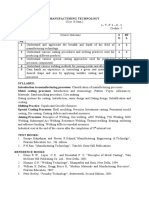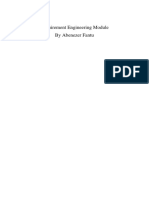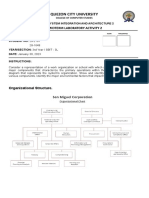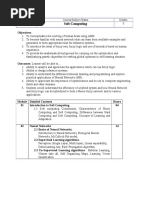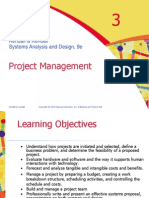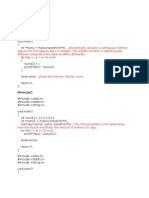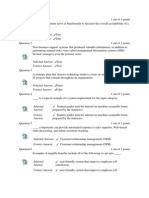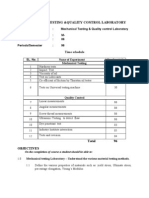OOP With C++
OOP With C++
Uploaded by
Vikram RaoCopyright:
Available Formats
OOP With C++
OOP With C++
Uploaded by
Vikram RaoOriginal Description:
Original Title
Copyright
Available Formats
Share this document
Did you find this document useful?
Is this content inappropriate?
Copyright:
Available Formats
OOP With C++
OOP With C++
Uploaded by
Vikram RaoCopyright:
Available Formats
Govt.
of Karnataka, Department of Technical Education Diploma in Information Science & Engineering Fourth Semester Subject: OOP with C++ Contact Hrs / week: 4
Table of Contents Chapter No 1 2 3 4 5 6 7 8 9 Topic Section I Introduction to OOP C++ Additional features Classes and Objects Section II Operator Overloading Inheritance Virtual functions Section III Managing Console I/O Operations Files Templates Seminars and Guest lectures from Industry and Institute Tests Total hrs Detailed Contents 1 1.1 1.2 1.3 1.4 1.5 1.6 1.7 2 2.1 2.2 2.3 2.4 2.5 2.6 Introduction to OOP Software evolution A look at procedure oriented programming Object oriented programming paradigm Basic concepts of OOPs Benefits of OOPs Objects oriented languages Application of OOPs C++ Additional Features What is C++? The i/o stream class Tokens Comments Basic data types, User defined data types, Derived data types Symbolic constants No. of Hrs 02 06 10 06 08 06 08 06 04 05 03 64 Marks 06 15 26 16 20 16 20 16 10
Total hrs: 64
145
2.7 2.8 2.9 2.10 2.11 2.12 2.13 2.14 2.15 2.16 2.17 2.18 2.16 3 3.1 3.2 3.2.1 3.2.2 3.2.3 3.3 3.3.1 3.3.2 3.4 3.5 3.6 3.7 3.8 3.9 3.10 3.10. 1 3.10. 2 3.10. 3 3.10. 4 3.10. 5 3.10. 6 3.11 3.12 3.13
Type Compatibility Declaration of variables Dynamic initialization of variables Reference variables Operators in C++: Scope resolution operator, Member dereferencing operators, Memory management operators Manipulators (setw & endl) Type cast operator Function prototyping Call by reference Return by reference Inline functions Default arguments Function overloading Classes and Objects C structures revisited Specifying a class A simple class example Creating objects Accessing class members Defining member functions Outside the class definition Inside the class definition A C++ program with class Memory allocation for objects Static data members Static member functions Arrays within a class Arrays of objects Constructors & Destructors Default constructors Parameterized constructor Overloaded constructor Constructor with default argument Copy constructor Destructor Objects as function arguments Returning objects from functions Friend functions
3.14 4 4.1 4.2 4.3 4.4 4.5 4.6 4.7 4.7.1 4.7.2 4.7.3 5 5.1 5.2 5.3 5.4 5.5 5.6 5.6.1 5.7 5.8 5.9 5.10 5.11 5.12 6 6.1 6.2 6.3 6.4 6.5 6.6 7 7.1 7.2 7.3 7.4 7.5 7.6 8 8.1 8.2 8.3 8.4
Friend Class (only definition) Operator Overloading Defining operator overloading Overloading unary operator Overloading binary operator Overloading binary operator using friends Manipulation of strings using operators Rules for overloading operator Type conversions Basic to class type Class to basic type One class to another class type Inheritance Introduction Defining Derived classes Single Inheritance Making a private member inheritable Multilevel inheritance Multiple inheritance Ambiguity resolution in inheritance Hierarchical inheritance Hybrid inheritance Virtual base classes Abstract classes Constructors in Derived classes Containership : nesting of classes Virtual Functions Pointers to objects this pointer Pointers to derived classes Virtual function Rules for virtual functions Pure virtual function Managing Console I/O Operations C++ streams C++ stream classes for console I/O operations Unformatted I/O operations Formatted console I/O operations Managing output with Manipulators Designing our own manipulator Files Classes for file stream operations Opening and closing a file Detecting end of file File modes
8.5 8.6 8.7 8.8 8.9 9 9.1 9.2 9.3 9.4
File pointers and their manipulation Sequential I/O operations Updating a file : Random Access Error handling functions Command line arguments Templates Class templates Function templates Member function templates Non Type Template argument
General Objectives: 1. 2. 3. 4. 5. 6. 7. 8. 9. Understand the concepts of OOPs, their advantages and applications Comprehend the features of C++ Know to create classes, objects, constructors and destructors Know the concepts and advantages of overloading operator and type conversions Appreciate the concepts of inheritance and the various types of inheritance. Understand virtual functions & their need and usage Appreciate the need for manipulators and the design of the same Use the various operations of files to perform file operations Understand the concept of templates.
Specific Objectives: Introduction to OOP Differentiate between procedure oriented and object oriented programming Learn the concepts and benefits of OOPs Appraise the applications of OOPs C++ Additional features Learn C++ keywords, constants, variable declarations and initialization Learn the use of scope resolution operator & memory management operators Learn to use IO Manipulators Write functions to implement call by reference and return by reference Learn the concepts of function overloading Classes and Objects Learn to create objects and access class members Learn to define member function within and outside the class definition Write C++ programs using classes Know about static data members and static functions Know various types of constructors & use of destructor Learn to use objects as function arguments and to return objects from functions Learn to use arrays and strings as class members
Write programs to implement array of objects Learn about friend functions and friend classes Operator Overloading Define operator overloading Learn to overload unary and binary operator Write programs to overload unary and binary operators Write programs to overload binary operator using friend functions Know the rules to be followed while overloading operators Know about various type conversions Inheritance Know the concepts of base class, derived class and derived class constructors Write programs to overload member functions Analyse the concept behind Single Inheritance (public & private) Differentiate between multilevel and multiple inheritance Differentiate between Hierarchical inheritance & hybrid inheritance Write programs to implement all the types of inheritance Learn about Virtual base classes and nesting of classes Write programs to implement virtual classes & nesting of classes Virtual functions Write programs to implement Pointers to objects Know the use of this pointer Write programs to implement Pointers to derived classes Know the concepts of Virtual function & pure virtual function. Implement them Managing Console I/O Operations Understand the concepts of console I/O operations Learn formatted and unformatted console I/O operations Know about Manipulators and implement own manipulators Files Know all the Classes for file stream operations Know all the operations and modes of a file Write programs to implement sequential I/O operations Learn to update a file in random access with error handling function. Templates Know about templates and their uses Implement function templates, member function templates Text Book: OBJECT ORIENTED PROGRAMMING WITH C++, 4E, E BALAGURUSAMY, Tata Mc Graw hill References: 1. Object oriented programming in c++, Dr.G.T. Thampi, Dr. S.s.Matha, Dreamtech, 2009 edition, 2. Object oriented programming in c++, Rajesh K Shukla , Wiely Precise text Book.2008.
3. Object Oriented Programming in Turbo C++ , Robert Lafore. 4. Object Oriented Programming with C++ , Sourav Sahay, Oxford Higher Education 5. C++ Complete Reference, Herbert Schilt. TMH. 6. Programming in C++ , M T Somashekar , PHI 7. Professional C++ , Wiley India (Wrox ) Govt. of Karnataka, Department of Technical Education Diploma in Information Science & Engineering Fourth Semester Subject: OOP with C++ Max. Marks: 100 Model Question Paper Note: 1. Section I is compulsory. 2. Answer any TWO questions from each remaining Sections. Marks Section I 1. a) Fill in the blanks with appropriate word/s i. is an alias name given to a variable. ii. . is a special member function that initializes the data members of a class. iii. The process of deriving one class from more than one base class is called----iv. A . Function can accept a value of any type. v. The ------ class provides the functionality for performing read operation from a file. b) Compare POP V/S OOP. Section II 2. a) Explain the const qualifier . b) Write a c++ program to illustrate an inline function. c) Explain function Overloading with an example 3. a) Define a class. b) Write a program to illustrate constructor overloading. c) Explain the concept of constructor with default arguments. 5 2 8 5 5 5 5 5x1=5 Max. Time: 3 Hours
4. a) What is a friend function? Explain with an example. b) How are static data members declared and defined? Explain. c) What is the significance of operator overloading?
5 6 4
Section III 5. a) Write a c++ program to add two complex objects by overloading the + operator. 10 b) What is type conversion? c) What is inheritance? List out the types of Inheritance. 6. a) What is Multiple Inheritance? Write a c++ program to illustrate Multiple Inheritance b) Explain the concept of Nesting of Classes. 7. a) Explain the use of this pointer. b) . Create a base class called 'SHAPE' having two data members of type double member function get-data( ) to initialize base class data members Pure virtual member function display-area ( ) to compute and display the area of the geometrical object. Derive two specific classes 'TRIANGLE' and 'RECTANGLE' from the base class. Using these three classes design a program that will accept dimension of a triangle / rectangle interactively and display the area. Section IV 8. a) With examples explain unformatted I /O operations. b) Explain the built in monitors in C++ with examples. 9. a) Write a program to illustrate the user defined manipulators with arguments. b) What are the built in classes for a file? Explain. c) What are the different modes to open a file? 10. a) Write a note on command line arguments. b) What is a template? 5 10 5 6 4 5 2 10 5 5 10 2 3
c) Write a program to illustrate class template with multiple parameters.
You might also like
- Operations ManagementDocument290 pagesOperations Managementrockon60595% (113)
- Drinks at Home 1Document13 pagesDrinks at Home 1Rick GinezNo ratings yet
- Module 3 - Computer Programming Development - Problem SolvingDocument77 pagesModule 3 - Computer Programming Development - Problem SolvingBukho TsengiweNo ratings yet
- Effective Output DesignDocument26 pagesEffective Output DesignBaldiaz Ryana SunaryoNo ratings yet
- Loewenstein Occupational Therapy Cognitive AssessmentDocument9 pagesLoewenstein Occupational Therapy Cognitive AssessmentDavid SugiartoNo ratings yet
- ITIPT02 - Lesson 1 Concepts of Mobile ApplicationsDocument23 pagesITIPT02 - Lesson 1 Concepts of Mobile ApplicationsGian Jerome RubioNo ratings yet
- 1 Manufacturing TechnologyDocument2 pages1 Manufacturing TechnologyNarasimha Murthy InampudiNo ratings yet
- Systems Analysis & Design: Tenth EditionDocument89 pagesSystems Analysis & Design: Tenth EditionThảo ThanhNo ratings yet
- Week 5.1 Business ModelsDocument20 pagesWeek 5.1 Business ModelsAnonymous 7Un6mnqJzNNo ratings yet
- 2016-2017 Computer Programming 2 SyllabusDocument22 pages2016-2017 Computer Programming 2 SyllabusRhey CostalesNo ratings yet
- IS2184 Information Systems ManagementDocument2 pagesIS2184 Information Systems ManagementMihirinie AbhayawardhanaNo ratings yet
- Input DesignDocument41 pagesInput Designedward arthurNo ratings yet
- CS368 Web TechnologiesDocument3 pagesCS368 Web TechnologiesShabin MuhammedNo ratings yet
- Chap 02 - Intro To Problem-Solving and Algorithm DesignDocument47 pagesChap 02 - Intro To Problem-Solving and Algorithm DesignHilman SyahiranNo ratings yet
- Software Project ManagmentDocument3 pagesSoftware Project ManagmentMani DkmNo ratings yet
- Problem Solving Skills - Way2tcsDocument302 pagesProblem Solving Skills - Way2tcsGaurav Jain100% (1)
- Agile Model and PrototypingDocument51 pagesAgile Model and PrototypingnaspuloyNo ratings yet
- System Administration and Maintenance FinalsDocument1 pageSystem Administration and Maintenance FinalsSun RainNo ratings yet
- Steps Involved in System Analysis and deDocument20 pagesSteps Involved in System Analysis and deSurya Ghanathe100% (1)
- Netwrorking 2Document3 pagesNetwrorking 2Renz Diego AngelesNo ratings yet
- Prototyping in Systems AnalysisDocument9 pagesPrototyping in Systems AnalysisDenisho Dee100% (1)
- Application Architecture and Modeling: C H A P T E RDocument53 pagesApplication Architecture and Modeling: C H A P T E RDaryl Ivan HisolaNo ratings yet
- Computer Organization and Architecture by William StallingDocument34 pagesComputer Organization and Architecture by William StallingFinding_Nemo4No ratings yet
- Systems Analysis & Design: Tenth EditionDocument61 pagesSystems Analysis & Design: Tenth EditionThảo ThanhNo ratings yet
- Requirement Engineering Module ReaDocument94 pagesRequirement Engineering Module Reaeliasferhan1992No ratings yet
- Data Structures and AlgorithmsDocument3 pagesData Structures and Algorithmsu chaitanyaNo ratings yet
- Tema 5 Tema 5 - Javascript Javascript and and Dom Dom: Software Software Engineering Engineering Group GroupDocument52 pagesTema 5 Tema 5 - Javascript Javascript and and Dom Dom: Software Software Engineering Engineering Group GroupLeri Blanco MarcosNo ratings yet
- 9.3 Decision TreesDocument17 pages9.3 Decision TreesBlessing MotaungNo ratings yet
- System Integration & Architecture: Nagwovuma MargaretDocument63 pagesSystem Integration & Architecture: Nagwovuma MargaretcietoNo ratings yet
- Sia102 Midterm Lab Activity 2Document4 pagesSia102 Midterm Lab Activity 2Vida, John PaulNo ratings yet
- Quantitative ApproachDocument18 pagesQuantitative ApproachSana Rafique0% (1)
- Systems Analysis & Design: Tenth EditionDocument60 pagesSystems Analysis & Design: Tenth EditionThảo Thanh100% (1)
- C++ Programming: From Problem Analysis To Program Design, Fifth EditionDocument38 pagesC++ Programming: From Problem Analysis To Program Design, Fifth Editionkyle_tosh3484No ratings yet
- HR SchemaDocument3 pagesHR SchemaLuiz Carlos Pires100% (1)
- Requirements Modelling StratigiesDocument74 pagesRequirements Modelling StratigiesHarsha PaniaNo ratings yet
- Elective-II Soft Computing PDFDocument3 pagesElective-II Soft Computing PDFKarthi BENo ratings yet
- Project Management: Kendall & Kendall Systems Analysis and Design, 9eDocument93 pagesProject Management: Kendall & Kendall Systems Analysis and Design, 9eNookala AbbhinavNo ratings yet
- CastingprocessesDocument31 pagesCastingprocessesAnonymous GGtvR65MRNo ratings yet
- Module 6Document34 pagesModule 6Brian Daniel BayotNo ratings yet
- Lab 08 Practice Exercise On MS-Excel: Objective Current Lab Learning Outcomes (LLO)Document3 pagesLab 08 Practice Exercise On MS-Excel: Objective Current Lab Learning Outcomes (LLO)Arabs are hilariousNo ratings yet
- Data Structures SyllabusDocument2 pagesData Structures SyllabusVishal JoshiNo ratings yet
- CS3451 Introduction To Operating Systems L T P CDocument4 pagesCS3451 Introduction To Operating Systems L T P CselviNo ratings yet
- Core PHP (Duration 20-22 Classes) Topics: PHP, Mysql, JavascriptDocument6 pagesCore PHP (Duration 20-22 Classes) Topics: PHP, Mysql, JavascriptGautam Mukherjee0% (1)
- Dotnet Lab Manual Even 2022Document134 pagesDotnet Lab Manual Even 2022Satyam RoyNo ratings yet
- Lesson 1 Introduction To Information SecurityDocument42 pagesLesson 1 Introduction To Information Securityrazel gicaleNo ratings yet
- Evolution of Programming Methodologies and Consepts of OopDocument48 pagesEvolution of Programming Methodologies and Consepts of OopSoumya Vijoy100% (1)
- CSC318 Web TechnologyDocument7 pagesCSC318 Web TechnologyMag CreationNo ratings yet
- Create The "Student Registration Form".Document14 pagesCreate The "Student Registration Form".lok eshNo ratings yet
- Analisis Dan Desain Sistem - Bab 5Document43 pagesAnalisis Dan Desain Sistem - Bab 5Nur Dzatu Ummu KhollilaNo ratings yet
- 3cs4-07 Software Engineering Unit - 1 NotesDocument30 pages3cs4-07 Software Engineering Unit - 1 Notesdileep bangad100% (1)
- MAD Lab ManualDocument83 pagesMAD Lab ManualKeerthana RNo ratings yet
- IT-423 System Integration and ArchitectureDocument7 pagesIT-423 System Integration and ArchitectureShanzay AliNo ratings yet
- Advance Python SyllabusDocument2 pagesAdvance Python Syllabusmihirmmb0% (1)
- C Programming Notes - Part 2Document16 pagesC Programming Notes - Part 2Ratnadeep BhattacharyaNo ratings yet
- Second Syllabus CC 105 Information ManagementDocument6 pagesSecond Syllabus CC 105 Information ManagementMichaelangelo R. SerranoNo ratings yet
- Moving Into ImplementationDocument11 pagesMoving Into ImplementationKylie Ivy Ramos AbangNo ratings yet
- OOSAD Assignment - 1Document3 pagesOOSAD Assignment - 1aberaf391No ratings yet
- Unit-4: Software Requirement EngineeringDocument80 pagesUnit-4: Software Requirement EngineeringNaman driveNo ratings yet
- CASE Tools 1Document53 pagesCASE Tools 1Liiswag MpNo ratings yet
- CTS-285 Study GuideDocument95 pagesCTS-285 Study GuideMax Potent100% (1)
- CSC 101 - ICT - Lab ManualDocument26 pagesCSC 101 - ICT - Lab ManualMuhammad AhmadNo ratings yet
- OOP With C++Document8 pagesOOP With C++Vikram RaoNo ratings yet
- C++ Question Bank (Internet)Document4 pagesC++ Question Bank (Internet)Gautam Kumar Samal100% (1)
- Design of Machine ElementsDocument53 pagesDesign of Machine ElementsSrks Kondal Reddy100% (2)
- Value Engineering ArticleDocument89 pagesValue Engineering ArticleVikram Rao100% (1)
- 2.thermal EngineeringDocument7 pages2.thermal EngineeringVikram Rao100% (1)
- 7.machine Shop IDocument2 pages7.machine Shop IVikram RaoNo ratings yet
- The Complete Sherlock HolmesDocument991 pagesThe Complete Sherlock HolmesVikram RaoNo ratings yet
- Mechanical Testing & Quality Control LabDocument4 pagesMechanical Testing & Quality Control LabVikram Rao100% (1)
- 5.fluid Power LabDocument4 pages5.fluid Power LabVikram RaoNo ratings yet
- Software EngineeringDocument8 pagesSoftware EngineeringVikram RaoNo ratings yet
- Manufacturing Tech-1Document6 pagesManufacturing Tech-1Vikram Rao0% (1)
- 2.fluid Mechanics and MachinesDocument9 pages2.fluid Mechanics and MachinesVikram RaoNo ratings yet
- 4.mechanical Measurements and MetrologyDocument6 pages4.mechanical Measurements and MetrologyVikram Rao100% (1)
- Linux LabDocument4 pagesLinux LabVikram RaoNo ratings yet
- MISDocument15 pagesMISVikram RaoNo ratings yet
- EM & SOMDocument8 pagesEM & SOMVikram RaoNo ratings yet
- DBMS LabDocument2 pagesDBMS LabVikram RaoNo ratings yet
- Data Structures Using CDocument7 pagesData Structures Using CVikram Rao100% (1)
- Transmission and DistributionDocument10 pagesTransmission and DistributionVikram Rao100% (1)
- DBMSDocument8 pagesDBMSVikram RaoNo ratings yet
- Ada TheoryDocument10 pagesAda TheoryVikram RaoNo ratings yet
- Power Electronics LabDocument4 pagesPower Electronics LabVikram RaoNo ratings yet
- Scheme 3rd & 4th SemDocument2 pagesScheme 3rd & 4th SemVikram RaoNo ratings yet
- Electrical Power GenerationDocument11 pagesElectrical Power GenerationVikram Rao0% (2)
- C - Programming LabDocument4 pagesC - Programming LabVikram RaoNo ratings yet
- Scheme of StudyDocument1 pageScheme of StudyVikram RaoNo ratings yet
- Oyewole Et Al 2021 - Corchorus Olitorius Stem As Corrosion Inhibitor On Mild Steel in Sulphuric AcidDocument7 pagesOyewole Et Al 2021 - Corchorus Olitorius Stem As Corrosion Inhibitor On Mild Steel in Sulphuric AcidTemitope OshinNo ratings yet
- iSmartAlarm System Owner's Manual PDFDocument40 pagesiSmartAlarm System Owner's Manual PDFdharamduttNo ratings yet
- DB6 Range - ALARM BELL - Up To 109 DB (A) : Exd, WeatherproofDocument2 pagesDB6 Range - ALARM BELL - Up To 109 DB (A) : Exd, WeatherproofNURUL AMALIN AISHAH AB MAJIDNo ratings yet
- Q1: Differentiate Between Conditional and Unconditional Security. AnswerDocument3 pagesQ1: Differentiate Between Conditional and Unconditional Security. AnswerRaja SalmanNo ratings yet
- PR 2 Exam For SubmissionDocument7 pagesPR 2 Exam For SubmissionRey Julius RanocoNo ratings yet
- Interdisciplinary Education and Art Appreciation AssignmentDocument5 pagesInterdisciplinary Education and Art Appreciation AssignmentSTEPHEN JAY BARREDONo ratings yet
- Metz 7ke: Halogen Free Silicate CementDocument2 pagesMetz 7ke: Halogen Free Silicate CementsonalisabirNo ratings yet
- Final Section 1 PDFDocument12 pagesFinal Section 1 PDFEva SmithNo ratings yet
- Stoerk 2004 enDocument199 pagesStoerk 2004 enSousaFVNo ratings yet
- Microprocessor Based System of Automatic Synchronizer ReportDocument23 pagesMicroprocessor Based System of Automatic Synchronizer ReportkarnatisharathNo ratings yet
- Renewable and Sustainable Energy Reviews: Ibrahim I. Enagi, K.A. Al-Attab, Z.A. ZainalDocument13 pagesRenewable and Sustainable Energy Reviews: Ibrahim I. Enagi, K.A. Al-Attab, Z.A. ZainalPhyo ThihabookNo ratings yet
- Ultratrex Dredging Pump CatalogDocument24 pagesUltratrex Dredging Pump CataloglucarsoNo ratings yet
- Reviewer Notes in General Biology 1Document1 pageReviewer Notes in General Biology 1Cassandra MhayNo ratings yet
- CBLM For PCBDocument35 pagesCBLM For PCBPaul Senen Didulo50% (2)
- University of Southeastern PhilippinesDocument7 pagesUniversity of Southeastern PhilippinesLyra SorrosaNo ratings yet
- RPH Properties of LightDocument17 pagesRPH Properties of LightMOHD HASRUL ASRAF BIN OTHMAN MoeNo ratings yet
- Blazevska Pottery Kilns in D Mitrevski eDocument33 pagesBlazevska Pottery Kilns in D Mitrevski eDarko TrajkovskiNo ratings yet
- Module 1.2 Engineering Data AnalysisDocument8 pagesModule 1.2 Engineering Data AnalysisDirect XNo ratings yet
- BM14G DatasheetDocument4 pagesBM14G DatasheetJona DanielNo ratings yet
- 2223 CSC14003 21CLC0607 HW01 SolutionDocument5 pages2223 CSC14003 21CLC0607 HW01 SolutionPhước Sang DươngNo ratings yet
- Mcom 2G 20120705Document513 pagesMcom 2G 20120705Fery SigiroNo ratings yet
- Jurnal 2Document23 pagesJurnal 2Anonymous iWqYLBewyNo ratings yet
- Hydraulic Flow UnitsDocument51 pagesHydraulic Flow UnitsNaufal FadhlurachmanNo ratings yet
- Introduction to Mathematical Statistics 7e 7th Edition Robert V. Hogg All Chapters Instant DownloadDocument67 pagesIntroduction to Mathematical Statistics 7e 7th Edition Robert V. Hogg All Chapters Instant Downloadattixluisibi100% (5)
- Slidesgo Input Devices Enhancing Interaction With Technology 20240619102029BHtBDocument14 pagesSlidesgo Input Devices Enhancing Interaction With Technology 20240619102029BHtBrahul.chauhan.105024No ratings yet
- Roads To Infinity - The Mathematics of Truth and Proof - StillwellDocument200 pagesRoads To Infinity - The Mathematics of Truth and Proof - Stillwellphuckyou45q4364100% (7)
- Pre-Enlistment Form For Irregular Students (Coecsa) : ME 501 Mell03E 2 ME 501 Pstl01E 1 ME 501 Caml01E 3Document1 pagePre-Enlistment Form For Irregular Students (Coecsa) : ME 501 Mell03E 2 ME 501 Pstl01E 1 ME 501 Caml01E 3kangkongNo ratings yet
- Institut Teknologi Sepuluh Nopember Transkrip Sementara / Temporary Academic TranscriptDocument1 pageInstitut Teknologi Sepuluh Nopember Transkrip Sementara / Temporary Academic TranscriptSyafrul MubaraqNo ratings yet






